Unconscionable Conducts in The Contracts
VerifiedAdded on 2023/01/13
|12
|3463
|53
AI Summary
This article discusses the concept of unconscionable conducts in contracts and explores the doctrines of duress and undue influence. It covers topics such as physical duress, duress to goods, and economic duress. It also explains the principles of actual undue influence and presumed undue influence.
Contribute Materials
Your contribution can guide someone’s learning journey. Share your
documents today.
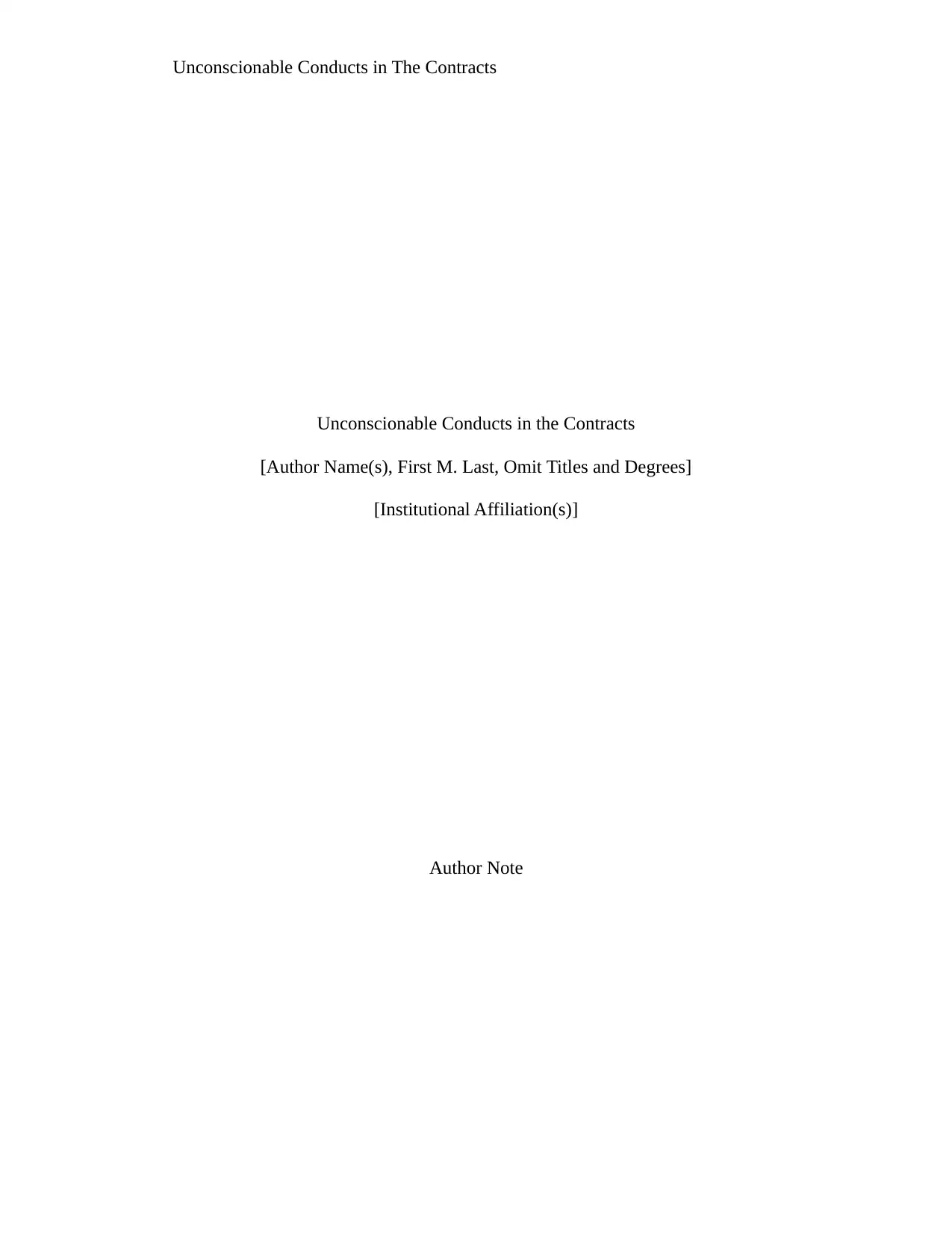
Unconscionable Conducts in The Contracts
Unconscionable Conducts in the Contracts
[Author Name(s), First M. Last, Omit Titles and Degrees]
[Institutional Affiliation(s)]
Author Note
Unconscionable Conducts in the Contracts
[Author Name(s), First M. Last, Omit Titles and Degrees]
[Institutional Affiliation(s)]
Author Note
Secure Best Marks with AI Grader
Need help grading? Try our AI Grader for instant feedback on your assignments.
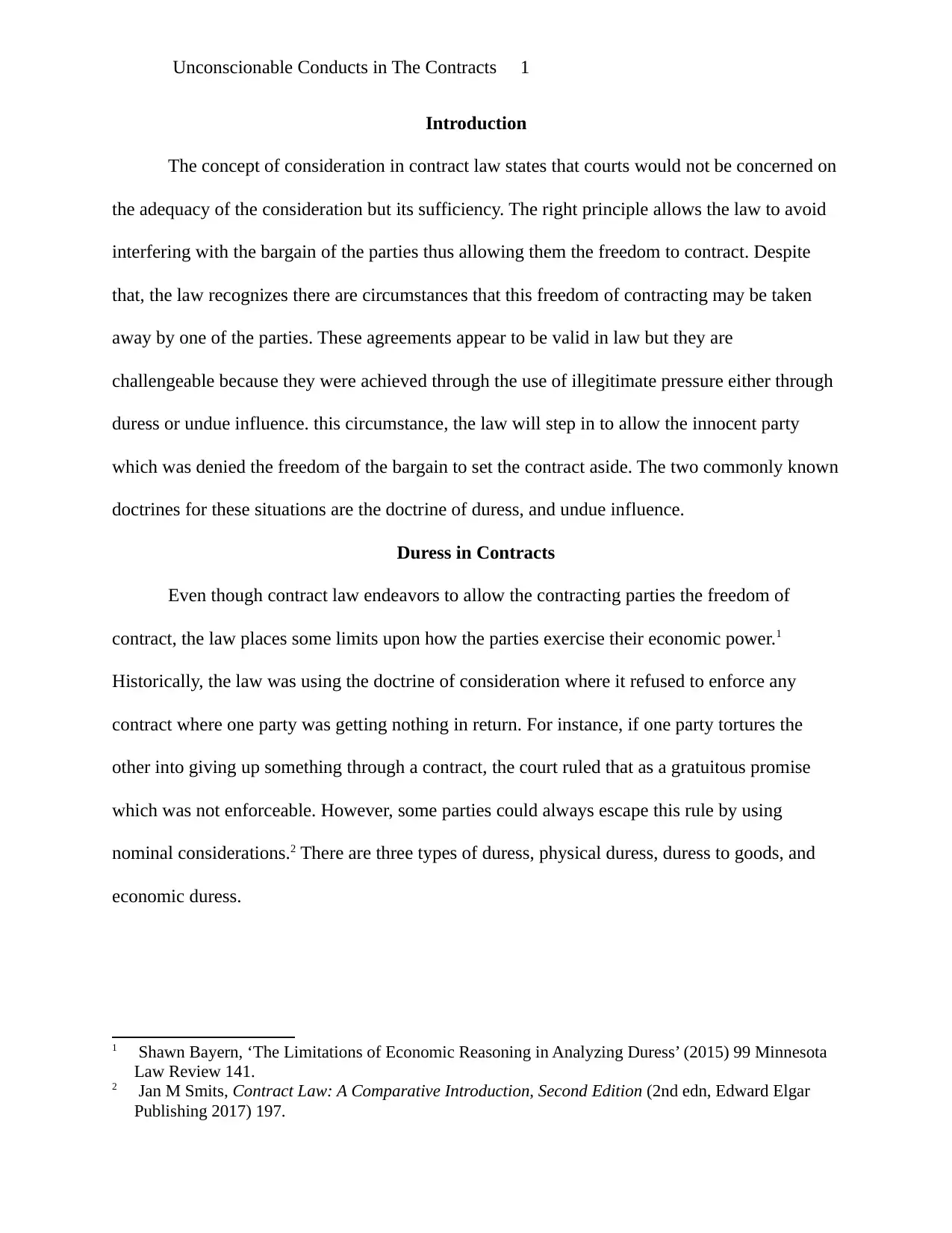
Unconscionable Conducts in The Contracts 1
Introduction
The concept of consideration in contract law states that courts would not be concerned on
the adequacy of the consideration but its sufficiency. The right principle allows the law to avoid
interfering with the bargain of the parties thus allowing them the freedom to contract. Despite
that, the law recognizes there are circumstances that this freedom of contracting may be taken
away by one of the parties. These agreements appear to be valid in law but they are
challengeable because they were achieved through the use of illegitimate pressure either through
duress or undue influence. this circumstance, the law will step in to allow the innocent party
which was denied the freedom of the bargain to set the contract aside. The two commonly known
doctrines for these situations are the doctrine of duress, and undue influence.
Duress in Contracts
Even though contract law endeavors to allow the contracting parties the freedom of
contract, the law places some limits upon how the parties exercise their economic power.1
Historically, the law was using the doctrine of consideration where it refused to enforce any
contract where one party was getting nothing in return. For instance, if one party tortures the
other into giving up something through a contract, the court ruled that as a gratuitous promise
which was not enforceable. However, some parties could always escape this rule by using
nominal considerations.2 There are three types of duress, physical duress, duress to goods, and
economic duress.
1 Shawn Bayern, ‘The Limitations of Economic Reasoning in Analyzing Duress’ (2015) 99 Minnesota
Law Review 141.
2 Jan M Smits, Contract Law: A Comparative Introduction, Second Edition (2nd edn, Edward Elgar
Publishing 2017) 197.
Introduction
The concept of consideration in contract law states that courts would not be concerned on
the adequacy of the consideration but its sufficiency. The right principle allows the law to avoid
interfering with the bargain of the parties thus allowing them the freedom to contract. Despite
that, the law recognizes there are circumstances that this freedom of contracting may be taken
away by one of the parties. These agreements appear to be valid in law but they are
challengeable because they were achieved through the use of illegitimate pressure either through
duress or undue influence. this circumstance, the law will step in to allow the innocent party
which was denied the freedom of the bargain to set the contract aside. The two commonly known
doctrines for these situations are the doctrine of duress, and undue influence.
Duress in Contracts
Even though contract law endeavors to allow the contracting parties the freedom of
contract, the law places some limits upon how the parties exercise their economic power.1
Historically, the law was using the doctrine of consideration where it refused to enforce any
contract where one party was getting nothing in return. For instance, if one party tortures the
other into giving up something through a contract, the court ruled that as a gratuitous promise
which was not enforceable. However, some parties could always escape this rule by using
nominal considerations.2 There are three types of duress, physical duress, duress to goods, and
economic duress.
1 Shawn Bayern, ‘The Limitations of Economic Reasoning in Analyzing Duress’ (2015) 99 Minnesota
Law Review 141.
2 Jan M Smits, Contract Law: A Comparative Introduction, Second Edition (2nd edn, Edward Elgar
Publishing 2017) 197.

Unconscionable Conducts in The Contracts 2
Physical Duress or Violence
Traditionally, the principles duress was limited to only cases of physical threat or
violence like the outcome of the case of Barton v Armstrong.3 The defendant was the Company’s
chairman who threatened the claimant to have him killed in case he refused to by the defendant’s
shares in the company.4 The court had an easier time finding that the claimant bought the shares
through not because of his will but because he was afraid of being killed. There were no
complications in dealing with issues of such direct duress. The English law considered cases of
coercion as duress which required equity to intervene. Despite that, cases of direct duress were
rare and problems arose where there was indirect duress or in cases of subtle methods of duress
like economic duress and duress to goods.5
Duress to Goods
The law dealing with matters of duress of goods has strict in limiting its scope. For
instance, the law had been reluctant in recognizing a promise to pay for the release of unlawfully
detained as duress.6 An example for such as situation was the Skeate v Beale where the court
held that duress that is limited to goods without extending to threat to the person was not enough
to bring a contract to an end.7 While this is the position of the law, there are a few exceptions
where money paid for the release of the unlawfully detained goods can be recovered. The
authority for such instances was the case of Astley v. Reynolds.8 In this case, the defendant
detained the plaintiff goods and asked him to pay £10 for them to be released. When the plaintiff
paid to recover the money, the court said that the money was recoverable.
3 Barton v Armstrong (1976) 1976 AC.
4 Williams v Roffey Bros & Nicholls (Contractors) Ltd (1991) 1991 QB 1.
5 TT Arvind, Contract Law (1st edn, Oxford University Press 2017) 339.
6 Richard Stone and James Devenney, Text, Cases and Materials on Contract Law (3rd edn, Routledge
2014) 445.
7 Skeate v Beale (1840) 11 Ad El.
8 Astley v Reynolds (1732) 2 Strange.
Physical Duress or Violence
Traditionally, the principles duress was limited to only cases of physical threat or
violence like the outcome of the case of Barton v Armstrong.3 The defendant was the Company’s
chairman who threatened the claimant to have him killed in case he refused to by the defendant’s
shares in the company.4 The court had an easier time finding that the claimant bought the shares
through not because of his will but because he was afraid of being killed. There were no
complications in dealing with issues of such direct duress. The English law considered cases of
coercion as duress which required equity to intervene. Despite that, cases of direct duress were
rare and problems arose where there was indirect duress or in cases of subtle methods of duress
like economic duress and duress to goods.5
Duress to Goods
The law dealing with matters of duress of goods has strict in limiting its scope. For
instance, the law had been reluctant in recognizing a promise to pay for the release of unlawfully
detained as duress.6 An example for such as situation was the Skeate v Beale where the court
held that duress that is limited to goods without extending to threat to the person was not enough
to bring a contract to an end.7 While this is the position of the law, there are a few exceptions
where money paid for the release of the unlawfully detained goods can be recovered. The
authority for such instances was the case of Astley v. Reynolds.8 In this case, the defendant
detained the plaintiff goods and asked him to pay £10 for them to be released. When the plaintiff
paid to recover the money, the court said that the money was recoverable.
3 Barton v Armstrong (1976) 1976 AC.
4 Williams v Roffey Bros & Nicholls (Contractors) Ltd (1991) 1991 QB 1.
5 TT Arvind, Contract Law (1st edn, Oxford University Press 2017) 339.
6 Richard Stone and James Devenney, Text, Cases and Materials on Contract Law (3rd edn, Routledge
2014) 445.
7 Skeate v Beale (1840) 11 Ad El.
8 Astley v Reynolds (1732) 2 Strange.
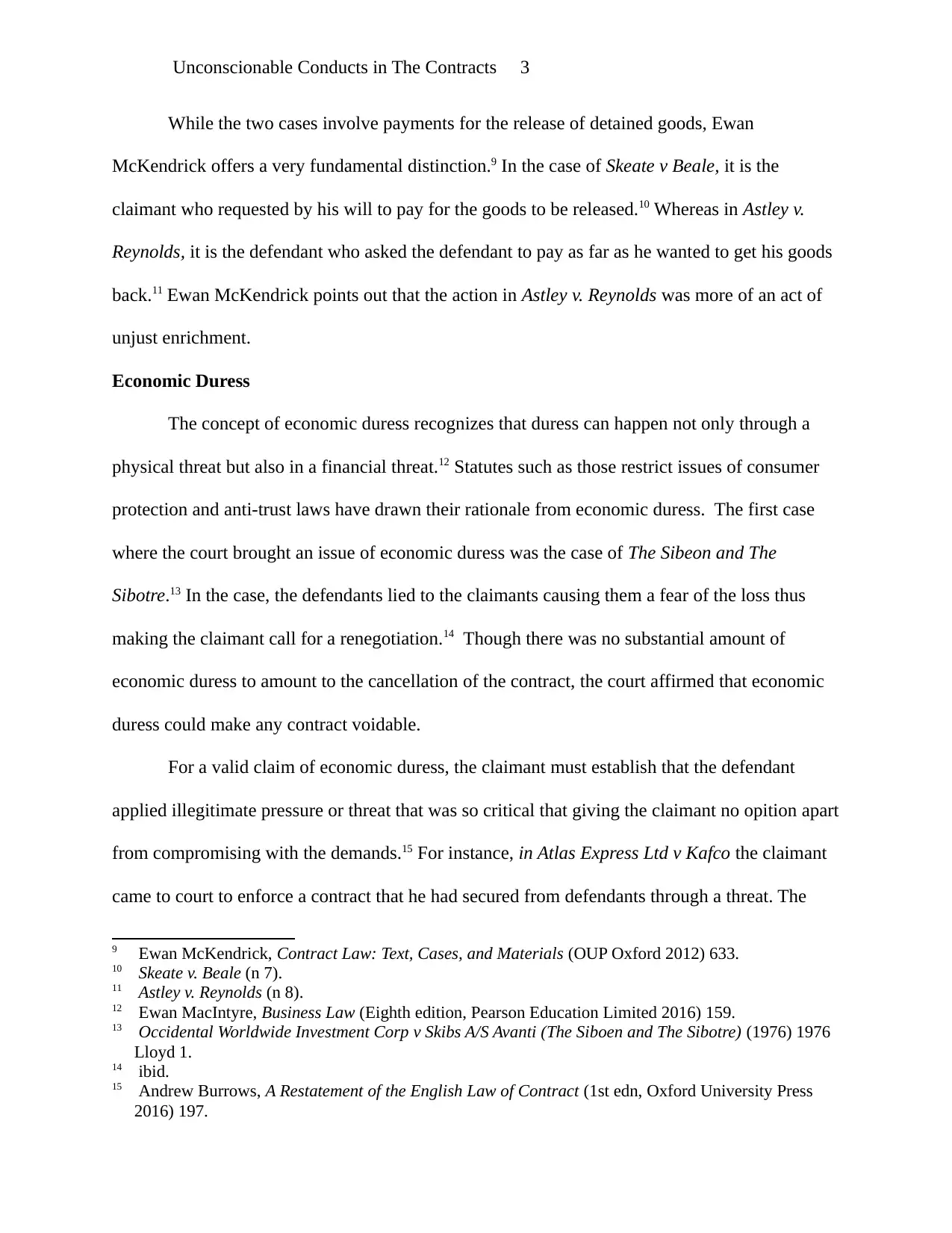
Unconscionable Conducts in The Contracts 3
While the two cases involve payments for the release of detained goods, Ewan
McKendrick offers a very fundamental distinction.9 In the case of Skeate v Beale, it is the
claimant who requested by his will to pay for the goods to be released.10 Whereas in Astley v.
Reynolds, it is the defendant who asked the defendant to pay as far as he wanted to get his goods
back.11 Ewan McKendrick points out that the action in Astley v. Reynolds was more of an act of
unjust enrichment.
Economic Duress
The concept of economic duress recognizes that duress can happen not only through a
physical threat but also in a financial threat.12 Statutes such as those restrict issues of consumer
protection and anti-trust laws have drawn their rationale from economic duress. The first case
where the court brought an issue of economic duress was the case of The Sibeon and The
Sibotre.13 In the case, the defendants lied to the claimants causing them a fear of the loss thus
making the claimant call for a renegotiation.14 Though there was no substantial amount of
economic duress to amount to the cancellation of the contract, the court affirmed that economic
duress could make any contract voidable.
For a valid claim of economic duress, the claimant must establish that the defendant
applied illegitimate pressure or threat that was so critical that giving the claimant no opition apart
from compromising with the demands.15 For instance, in Atlas Express Ltd v Kafco the claimant
came to court to enforce a contract that he had secured from defendants through a threat. The
9 Ewan McKendrick, Contract Law: Text, Cases, and Materials (OUP Oxford 2012) 633.
10 Skeate v. Beale (n 7).
11 Astley v. Reynolds (n 8).
12 Ewan MacIntyre, Business Law (Eighth edition, Pearson Education Limited 2016) 159.
13 Occidental Worldwide Investment Corp v Skibs A/S Avanti (The Siboen and The Sibotre) (1976) 1976
Lloyd 1.
14 ibid.
15 Andrew Burrows, A Restatement of the English Law of Contract (1st edn, Oxford University Press
2016) 197.
While the two cases involve payments for the release of detained goods, Ewan
McKendrick offers a very fundamental distinction.9 In the case of Skeate v Beale, it is the
claimant who requested by his will to pay for the goods to be released.10 Whereas in Astley v.
Reynolds, it is the defendant who asked the defendant to pay as far as he wanted to get his goods
back.11 Ewan McKendrick points out that the action in Astley v. Reynolds was more of an act of
unjust enrichment.
Economic Duress
The concept of economic duress recognizes that duress can happen not only through a
physical threat but also in a financial threat.12 Statutes such as those restrict issues of consumer
protection and anti-trust laws have drawn their rationale from economic duress. The first case
where the court brought an issue of economic duress was the case of The Sibeon and The
Sibotre.13 In the case, the defendants lied to the claimants causing them a fear of the loss thus
making the claimant call for a renegotiation.14 Though there was no substantial amount of
economic duress to amount to the cancellation of the contract, the court affirmed that economic
duress could make any contract voidable.
For a valid claim of economic duress, the claimant must establish that the defendant
applied illegitimate pressure or threat that was so critical that giving the claimant no opition apart
from compromising with the demands.15 For instance, in Atlas Express Ltd v Kafco the claimant
came to court to enforce a contract that he had secured from defendants through a threat. The
9 Ewan McKendrick, Contract Law: Text, Cases, and Materials (OUP Oxford 2012) 633.
10 Skeate v. Beale (n 7).
11 Astley v. Reynolds (n 8).
12 Ewan MacIntyre, Business Law (Eighth edition, Pearson Education Limited 2016) 159.
13 Occidental Worldwide Investment Corp v Skibs A/S Avanti (The Siboen and The Sibotre) (1976) 1976
Lloyd 1.
14 ibid.
15 Andrew Burrows, A Restatement of the English Law of Contract (1st edn, Oxford University Press
2016) 197.
Secure Best Marks with AI Grader
Need help grading? Try our AI Grader for instant feedback on your assignments.

Unconscionable Conducts in The Contracts 4
claimant had threatened to take no loads if defendants would not accept to change the price.
Given that this was a contract that they had negotiated and the defendants would have undergone
some loss if they refused, they agreed to renegotiate but later refused to pay. The court rejected
the claimant’s case stating that he had given the defendants no other option.
A similar ruling was held in Kolmar Group AG case where the defendant hiked the price
after they had made a deal to supply methanol.16 Given that the Claimant had no option because
he had a client waiting, he had to accept the deal. The Court found that there was illegitimate
pressure and ordered the defendant to take the original price. A similar decision also came up in
The Evia Luck case.17 The case arose when the defendants threatened the ship owner that they
would black-list his ship unless he complied with their demands which included some payments.
The owner paid, but he brought an action where he succeeded in recovering his money. In
Williams v Roffey Bros decision, the Court reiterated that economic duress it would always
provide a remedy to cases involving economical duress since the contracts are orchestrated
through unfair pressure.18
As the cases of economic duress increases, the Privy Council in Pao On v Lau Yiu Lung
provided a formula for finding economic duress.19 The Privy Council provided four elements that
would constitute economic duress. These elements were a sign of protest from the person
claiming to have been coerced, lack of other alternatives that the claimant would have taken,
availability of independent advice to the claimant, and steps taken by the claimant to avoid the
unfair contract after its formation.20 A situation where the court found no duress because there
were other alternatives were found in the case of CTN Cash and Carry v Gallaher.21 In this case,
16 Kolmar Group AG v Traxpo Enterprises Pvt Ltd (2010) 2010 EWHC.
17 Dimskal Shipping v ITWF (The Evia Luck) (1991) 871 4 ER (Court of Appeal).
18 Williams v. Roffey Bros & Nicholls (Contractors) Ltd (n 4).
19 Pao on v Lau Yiu Long (1979) 65 Privy Council 3 ER.
20 ibid.
21 CTN Cash and Carry Ltd v Gallaher Ltd (1994) 1994 ER 4.
claimant had threatened to take no loads if defendants would not accept to change the price.
Given that this was a contract that they had negotiated and the defendants would have undergone
some loss if they refused, they agreed to renegotiate but later refused to pay. The court rejected
the claimant’s case stating that he had given the defendants no other option.
A similar ruling was held in Kolmar Group AG case where the defendant hiked the price
after they had made a deal to supply methanol.16 Given that the Claimant had no option because
he had a client waiting, he had to accept the deal. The Court found that there was illegitimate
pressure and ordered the defendant to take the original price. A similar decision also came up in
The Evia Luck case.17 The case arose when the defendants threatened the ship owner that they
would black-list his ship unless he complied with their demands which included some payments.
The owner paid, but he brought an action where he succeeded in recovering his money. In
Williams v Roffey Bros decision, the Court reiterated that economic duress it would always
provide a remedy to cases involving economical duress since the contracts are orchestrated
through unfair pressure.18
As the cases of economic duress increases, the Privy Council in Pao On v Lau Yiu Lung
provided a formula for finding economic duress.19 The Privy Council provided four elements that
would constitute economic duress. These elements were a sign of protest from the person
claiming to have been coerced, lack of other alternatives that the claimant would have taken,
availability of independent advice to the claimant, and steps taken by the claimant to avoid the
unfair contract after its formation.20 A situation where the court found no duress because there
were other alternatives were found in the case of CTN Cash and Carry v Gallaher.21 In this case,
16 Kolmar Group AG v Traxpo Enterprises Pvt Ltd (2010) 2010 EWHC.
17 Dimskal Shipping v ITWF (The Evia Luck) (1991) 871 4 ER (Court of Appeal).
18 Williams v. Roffey Bros & Nicholls (Contractors) Ltd (n 4).
19 Pao on v Lau Yiu Long (1979) 65 Privy Council 3 ER.
20 ibid.
21 CTN Cash and Carry Ltd v Gallaher Ltd (1994) 1994 ER 4.

Unconscionable Conducts in The Contracts 5
the court found that the threat that the claimant was complaining of was merely the defendants’
plan to alter the terms of suppliance but not to cancel the contract.
Undue Influence
Contract law has developed the doctrine of undue influence through equity which makes
some contracts voidable. Since it is based on equitable principles, issues brought to court through
this doctrine are left under the court’ discretion.22 In particular, undue influence deals with
situations where one party uses inappropriate pressure on the other party to procure a contract. In
other words, a pressure in the contract is legal, it only becomes illegal when it was applied
inappropriately. Courts have mainly found victims of undue influence suffering from emotional
or physical imbalance, and they gave up their consent on the contract not because of their will,
but because of the manipulation of their vulnerabilities. An explanation of undue influence was
elaborated in Daniel v Drew that cases of undue influence call for the analysis whether influence
invaded donor’s free volition in accepting or rejecting the advice.23 The law separates undue
influence into two. The first one is the actual undue influence which is more direct. The second
one is the presumed undue influence.
Actual undue influence
Establishing actual undue influence requires the victim to demonstrate that they were
genuinely intimidated into making the contract. To allow a claim of actual undue influence, the
law requires the victim to show that the other party dominated over to an extent that the claimant
could not act independently or use his/her own will.24 Proving actual undue influence is more of
a subjective test where the court would have to take considerations of whether the actual victim
honestly believed. It is not an objective test where considerations of a reasonable person given
22 Stone and Devenney (n 6) 464.
23 Daniel v Drew (2005) 507 EWCA Civ.
24 Burrows (n 15) 201.
the court found that the threat that the claimant was complaining of was merely the defendants’
plan to alter the terms of suppliance but not to cancel the contract.
Undue Influence
Contract law has developed the doctrine of undue influence through equity which makes
some contracts voidable. Since it is based on equitable principles, issues brought to court through
this doctrine are left under the court’ discretion.22 In particular, undue influence deals with
situations where one party uses inappropriate pressure on the other party to procure a contract. In
other words, a pressure in the contract is legal, it only becomes illegal when it was applied
inappropriately. Courts have mainly found victims of undue influence suffering from emotional
or physical imbalance, and they gave up their consent on the contract not because of their will,
but because of the manipulation of their vulnerabilities. An explanation of undue influence was
elaborated in Daniel v Drew that cases of undue influence call for the analysis whether influence
invaded donor’s free volition in accepting or rejecting the advice.23 The law separates undue
influence into two. The first one is the actual undue influence which is more direct. The second
one is the presumed undue influence.
Actual undue influence
Establishing actual undue influence requires the victim to demonstrate that they were
genuinely intimidated into making the contract. To allow a claim of actual undue influence, the
law requires the victim to show that the other party dominated over to an extent that the claimant
could not act independently or use his/her own will.24 Proving actual undue influence is more of
a subjective test where the court would have to take considerations of whether the actual victim
honestly believed. It is not an objective test where considerations of a reasonable person given
22 Stone and Devenney (n 6) 464.
23 Daniel v Drew (2005) 507 EWCA Civ.
24 Burrows (n 15) 201.
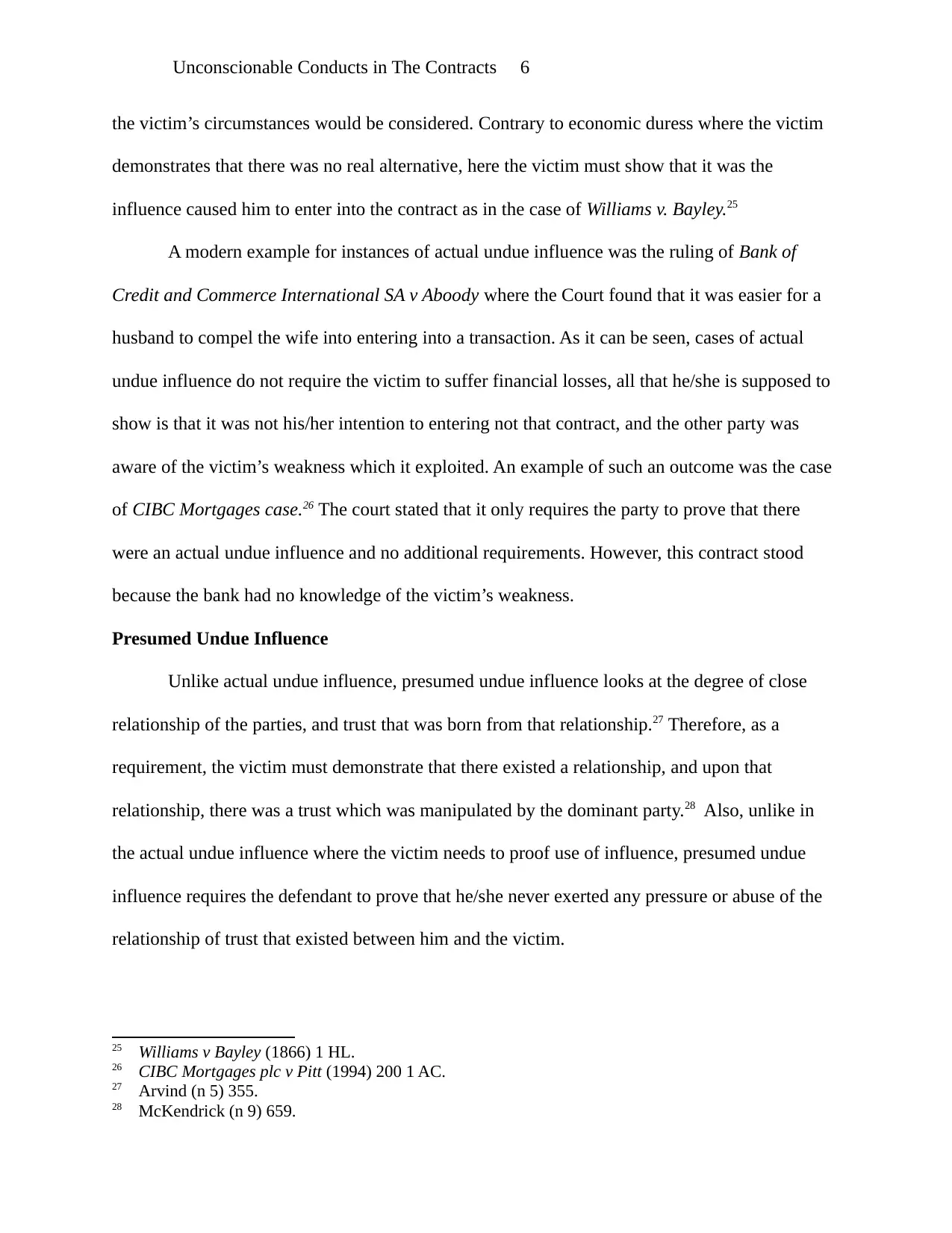
Unconscionable Conducts in The Contracts 6
the victim’s circumstances would be considered. Contrary to economic duress where the victim
demonstrates that there was no real alternative, here the victim must show that it was the
influence caused him to enter into the contract as in the case of Williams v. Bayley.25
A modern example for instances of actual undue influence was the ruling of Bank of
Credit and Commerce International SA v Aboody where the Court found that it was easier for a
husband to compel the wife into entering into a transaction. As it can be seen, cases of actual
undue influence do not require the victim to suffer financial losses, all that he/she is supposed to
show is that it was not his/her intention to entering not that contract, and the other party was
aware of the victim’s weakness which it exploited. An example of such an outcome was the case
of CIBC Mortgages case.26 The court stated that it only requires the party to prove that there
were an actual undue influence and no additional requirements. However, this contract stood
because the bank had no knowledge of the victim’s weakness.
Presumed Undue Influence
Unlike actual undue influence, presumed undue influence looks at the degree of close
relationship of the parties, and trust that was born from that relationship.27 Therefore, as a
requirement, the victim must demonstrate that there existed a relationship, and upon that
relationship, there was a trust which was manipulated by the dominant party.28 Also, unlike in
the actual undue influence where the victim needs to proof use of influence, presumed undue
influence requires the defendant to prove that he/she never exerted any pressure or abuse of the
relationship of trust that existed between him and the victim.
25 Williams v Bayley (1866) 1 HL.
26 CIBC Mortgages plc v Pitt (1994) 200 1 AC.
27 Arvind (n 5) 355.
28 McKendrick (n 9) 659.
the victim’s circumstances would be considered. Contrary to economic duress where the victim
demonstrates that there was no real alternative, here the victim must show that it was the
influence caused him to enter into the contract as in the case of Williams v. Bayley.25
A modern example for instances of actual undue influence was the ruling of Bank of
Credit and Commerce International SA v Aboody where the Court found that it was easier for a
husband to compel the wife into entering into a transaction. As it can be seen, cases of actual
undue influence do not require the victim to suffer financial losses, all that he/she is supposed to
show is that it was not his/her intention to entering not that contract, and the other party was
aware of the victim’s weakness which it exploited. An example of such an outcome was the case
of CIBC Mortgages case.26 The court stated that it only requires the party to prove that there
were an actual undue influence and no additional requirements. However, this contract stood
because the bank had no knowledge of the victim’s weakness.
Presumed Undue Influence
Unlike actual undue influence, presumed undue influence looks at the degree of close
relationship of the parties, and trust that was born from that relationship.27 Therefore, as a
requirement, the victim must demonstrate that there existed a relationship, and upon that
relationship, there was a trust which was manipulated by the dominant party.28 Also, unlike in
the actual undue influence where the victim needs to proof use of influence, presumed undue
influence requires the defendant to prove that he/she never exerted any pressure or abuse of the
relationship of trust that existed between him and the victim.
25 Williams v Bayley (1866) 1 HL.
26 CIBC Mortgages plc v Pitt (1994) 200 1 AC.
27 Arvind (n 5) 355.
28 McKendrick (n 9) 659.
Paraphrase This Document
Need a fresh take? Get an instant paraphrase of this document with our AI Paraphraser
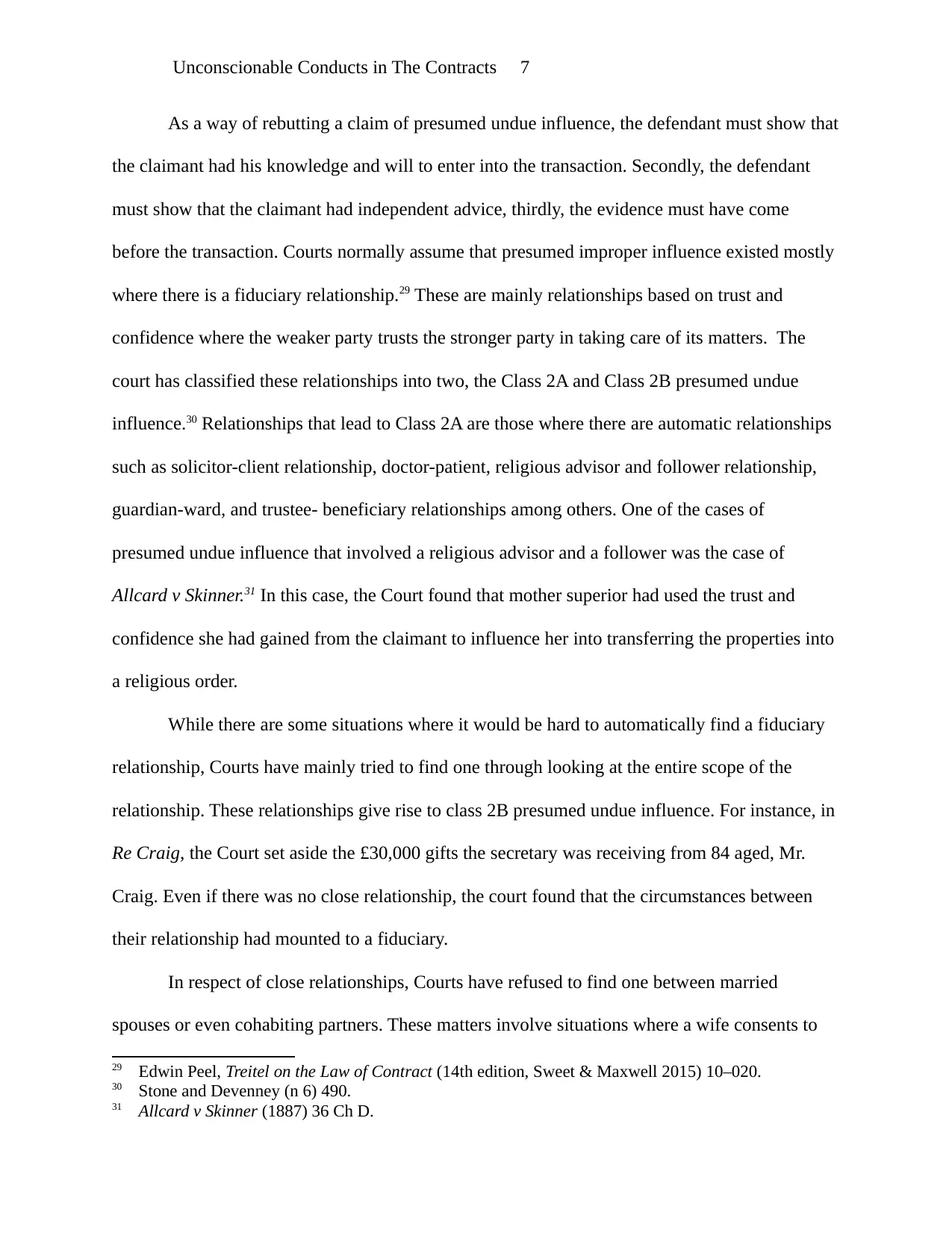
Unconscionable Conducts in The Contracts 7
As a way of rebutting a claim of presumed undue influence, the defendant must show that
the claimant had his knowledge and will to enter into the transaction. Secondly, the defendant
must show that the claimant had independent advice, thirdly, the evidence must have come
before the transaction. Courts normally assume that presumed improper influence existed mostly
where there is a fiduciary relationship.29 These are mainly relationships based on trust and
confidence where the weaker party trusts the stronger party in taking care of its matters. The
court has classified these relationships into two, the Class 2A and Class 2B presumed undue
influence.30 Relationships that lead to Class 2A are those where there are automatic relationships
such as solicitor-client relationship, doctor-patient, religious advisor and follower relationship,
guardian-ward, and trustee- beneficiary relationships among others. One of the cases of
presumed undue influence that involved a religious advisor and a follower was the case of
Allcard v Skinner.31 In this case, the Court found that mother superior had used the trust and
confidence she had gained from the claimant to influence her into transferring the properties into
a religious order.
While there are some situations where it would be hard to automatically find a fiduciary
relationship, Courts have mainly tried to find one through looking at the entire scope of the
relationship. These relationships give rise to class 2B presumed undue influence. For instance, in
Re Craig, the Court set aside the £30,000 gifts the secretary was receiving from 84 aged, Mr.
Craig. Even if there was no close relationship, the court found that the circumstances between
their relationship had mounted to a fiduciary.
In respect of close relationships, Courts have refused to find one between married
spouses or even cohabiting partners. These matters involve situations where a wife consents to
29 Edwin Peel, Treitel on the Law of Contract (14th edition, Sweet & Maxwell 2015) 10–020.
30 Stone and Devenney (n 6) 490.
31 Allcard v Skinner (1887) 36 Ch D.
As a way of rebutting a claim of presumed undue influence, the defendant must show that
the claimant had his knowledge and will to enter into the transaction. Secondly, the defendant
must show that the claimant had independent advice, thirdly, the evidence must have come
before the transaction. Courts normally assume that presumed improper influence existed mostly
where there is a fiduciary relationship.29 These are mainly relationships based on trust and
confidence where the weaker party trusts the stronger party in taking care of its matters. The
court has classified these relationships into two, the Class 2A and Class 2B presumed undue
influence.30 Relationships that lead to Class 2A are those where there are automatic relationships
such as solicitor-client relationship, doctor-patient, religious advisor and follower relationship,
guardian-ward, and trustee- beneficiary relationships among others. One of the cases of
presumed undue influence that involved a religious advisor and a follower was the case of
Allcard v Skinner.31 In this case, the Court found that mother superior had used the trust and
confidence she had gained from the claimant to influence her into transferring the properties into
a religious order.
While there are some situations where it would be hard to automatically find a fiduciary
relationship, Courts have mainly tried to find one through looking at the entire scope of the
relationship. These relationships give rise to class 2B presumed undue influence. For instance, in
Re Craig, the Court set aside the £30,000 gifts the secretary was receiving from 84 aged, Mr.
Craig. Even if there was no close relationship, the court found that the circumstances between
their relationship had mounted to a fiduciary.
In respect of close relationships, Courts have refused to find one between married
spouses or even cohabiting partners. These matters involve situations where a wife consents to
29 Edwin Peel, Treitel on the Law of Contract (14th edition, Sweet & Maxwell 2015) 10–020.
30 Stone and Devenney (n 6) 490.
31 Allcard v Skinner (1887) 36 Ch D.
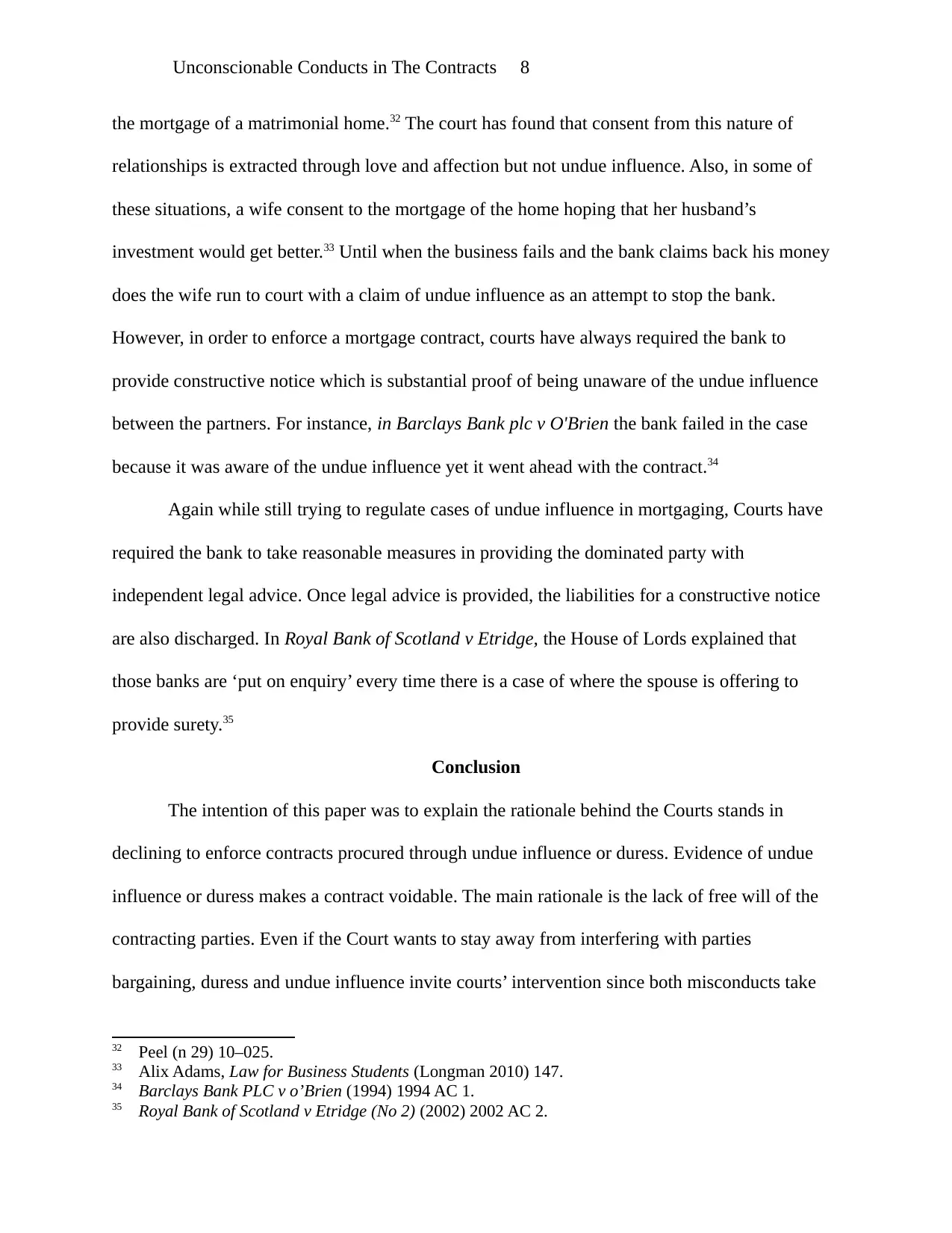
Unconscionable Conducts in The Contracts 8
the mortgage of a matrimonial home.32 The court has found that consent from this nature of
relationships is extracted through love and affection but not undue influence. Also, in some of
these situations, a wife consent to the mortgage of the home hoping that her husband’s
investment would get better.33 Until when the business fails and the bank claims back his money
does the wife run to court with a claim of undue influence as an attempt to stop the bank.
However, in order to enforce a mortgage contract, courts have always required the bank to
provide constructive notice which is substantial proof of being unaware of the undue influence
between the partners. For instance, in Barclays Bank plc v O'Brien the bank failed in the case
because it was aware of the undue influence yet it went ahead with the contract.34
Again while still trying to regulate cases of undue influence in mortgaging, Courts have
required the bank to take reasonable measures in providing the dominated party with
independent legal advice. Once legal advice is provided, the liabilities for a constructive notice
are also discharged. In Royal Bank of Scotland v Etridge, the House of Lords explained that
those banks are ‘put on enquiry’ every time there is a case of where the spouse is offering to
provide surety.35
Conclusion
The intention of this paper was to explain the rationale behind the Courts stands in
declining to enforce contracts procured through undue influence or duress. Evidence of undue
influence or duress makes a contract voidable. The main rationale is the lack of free will of the
contracting parties. Even if the Court wants to stay away from interfering with parties
bargaining, duress and undue influence invite courts’ intervention since both misconducts take
32 Peel (n 29) 10–025.
33 Alix Adams, Law for Business Students (Longman 2010) 147.
34 Barclays Bank PLC v o’Brien (1994) 1994 AC 1.
35 Royal Bank of Scotland v Etridge (No 2) (2002) 2002 AC 2.
the mortgage of a matrimonial home.32 The court has found that consent from this nature of
relationships is extracted through love and affection but not undue influence. Also, in some of
these situations, a wife consent to the mortgage of the home hoping that her husband’s
investment would get better.33 Until when the business fails and the bank claims back his money
does the wife run to court with a claim of undue influence as an attempt to stop the bank.
However, in order to enforce a mortgage contract, courts have always required the bank to
provide constructive notice which is substantial proof of being unaware of the undue influence
between the partners. For instance, in Barclays Bank plc v O'Brien the bank failed in the case
because it was aware of the undue influence yet it went ahead with the contract.34
Again while still trying to regulate cases of undue influence in mortgaging, Courts have
required the bank to take reasonable measures in providing the dominated party with
independent legal advice. Once legal advice is provided, the liabilities for a constructive notice
are also discharged. In Royal Bank of Scotland v Etridge, the House of Lords explained that
those banks are ‘put on enquiry’ every time there is a case of where the spouse is offering to
provide surety.35
Conclusion
The intention of this paper was to explain the rationale behind the Courts stands in
declining to enforce contracts procured through undue influence or duress. Evidence of undue
influence or duress makes a contract voidable. The main rationale is the lack of free will of the
contracting parties. Even if the Court wants to stay away from interfering with parties
bargaining, duress and undue influence invite courts’ intervention since both misconducts take
32 Peel (n 29) 10–025.
33 Alix Adams, Law for Business Students (Longman 2010) 147.
34 Barclays Bank PLC v o’Brien (1994) 1994 AC 1.
35 Royal Bank of Scotland v Etridge (No 2) (2002) 2002 AC 2.
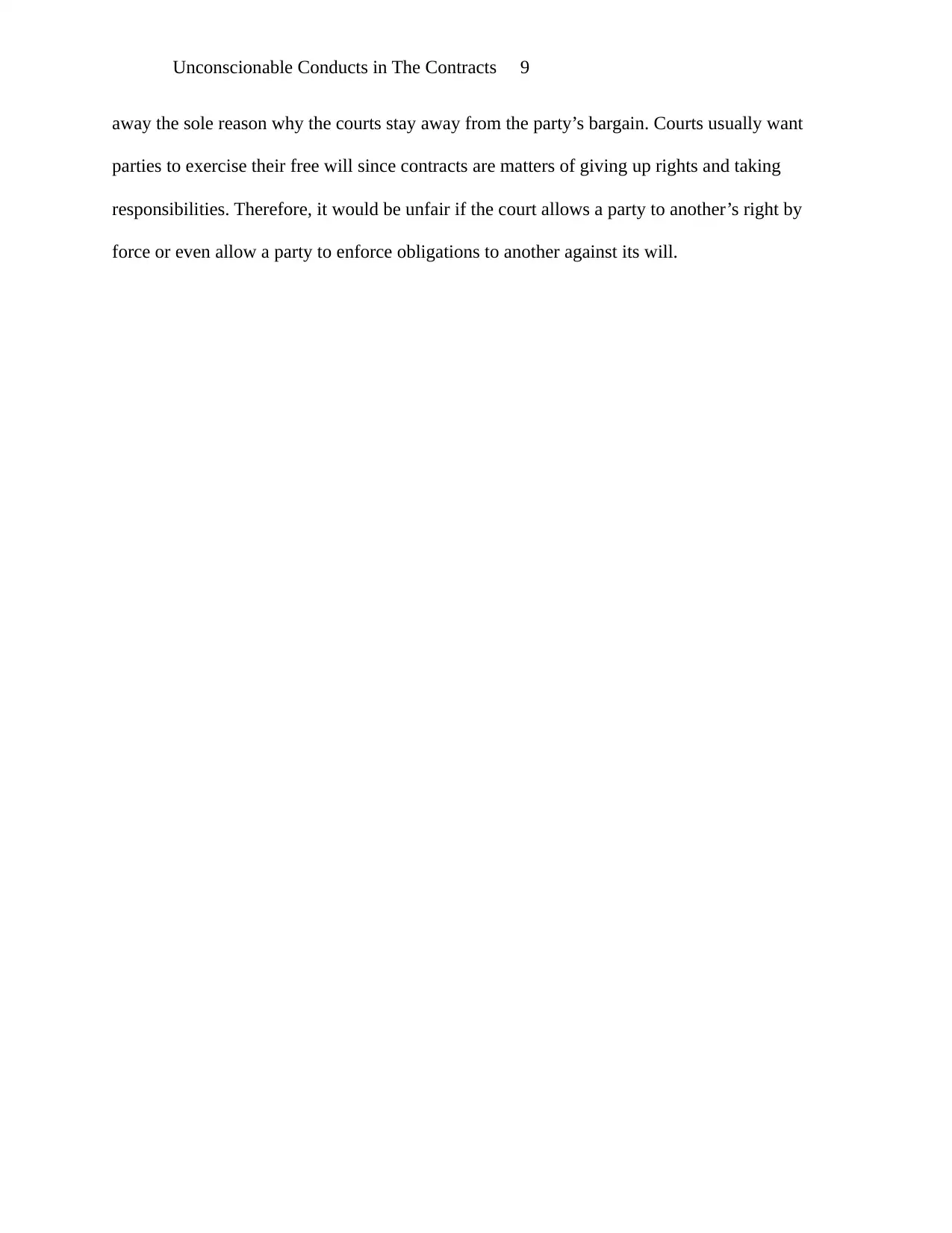
Unconscionable Conducts in The Contracts 9
away the sole reason why the courts stay away from the party’s bargain. Courts usually want
parties to exercise their free will since contracts are matters of giving up rights and taking
responsibilities. Therefore, it would be unfair if the court allows a party to another’s right by
force or even allow a party to enforce obligations to another against its will.
away the sole reason why the courts stay away from the party’s bargain. Courts usually want
parties to exercise their free will since contracts are matters of giving up rights and taking
responsibilities. Therefore, it would be unfair if the court allows a party to another’s right by
force or even allow a party to enforce obligations to another against its will.
Secure Best Marks with AI Grader
Need help grading? Try our AI Grader for instant feedback on your assignments.
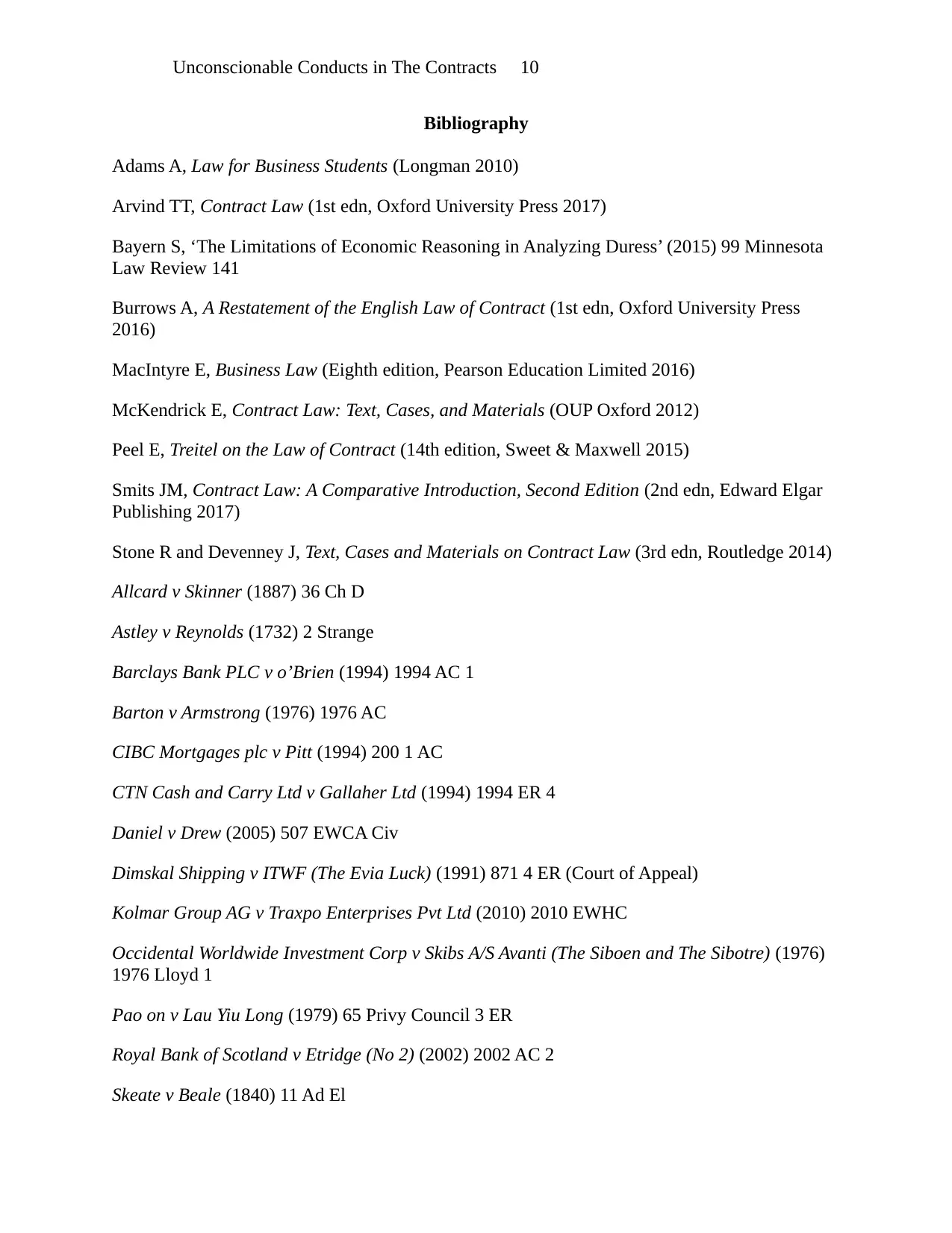
Unconscionable Conducts in The Contracts 10
Bibliography
Adams A, Law for Business Students (Longman 2010)
Arvind TT, Contract Law (1st edn, Oxford University Press 2017)
Bayern S, ‘The Limitations of Economic Reasoning in Analyzing Duress’ (2015) 99 Minnesota
Law Review 141
Burrows A, A Restatement of the English Law of Contract (1st edn, Oxford University Press
2016)
MacIntyre E, Business Law (Eighth edition, Pearson Education Limited 2016)
McKendrick E, Contract Law: Text, Cases, and Materials (OUP Oxford 2012)
Peel E, Treitel on the Law of Contract (14th edition, Sweet & Maxwell 2015)
Smits JM, Contract Law: A Comparative Introduction, Second Edition (2nd edn, Edward Elgar
Publishing 2017)
Stone R and Devenney J, Text, Cases and Materials on Contract Law (3rd edn, Routledge 2014)
Allcard v Skinner (1887) 36 Ch D
Astley v Reynolds (1732) 2 Strange
Barclays Bank PLC v o’Brien (1994) 1994 AC 1
Barton v Armstrong (1976) 1976 AC
CIBC Mortgages plc v Pitt (1994) 200 1 AC
CTN Cash and Carry Ltd v Gallaher Ltd (1994) 1994 ER 4
Daniel v Drew (2005) 507 EWCA Civ
Dimskal Shipping v ITWF (The Evia Luck) (1991) 871 4 ER (Court of Appeal)
Kolmar Group AG v Traxpo Enterprises Pvt Ltd (2010) 2010 EWHC
Occidental Worldwide Investment Corp v Skibs A/S Avanti (The Siboen and The Sibotre) (1976)
1976 Lloyd 1
Pao on v Lau Yiu Long (1979) 65 Privy Council 3 ER
Royal Bank of Scotland v Etridge (No 2) (2002) 2002 AC 2
Skeate v Beale (1840) 11 Ad El
Bibliography
Adams A, Law for Business Students (Longman 2010)
Arvind TT, Contract Law (1st edn, Oxford University Press 2017)
Bayern S, ‘The Limitations of Economic Reasoning in Analyzing Duress’ (2015) 99 Minnesota
Law Review 141
Burrows A, A Restatement of the English Law of Contract (1st edn, Oxford University Press
2016)
MacIntyre E, Business Law (Eighth edition, Pearson Education Limited 2016)
McKendrick E, Contract Law: Text, Cases, and Materials (OUP Oxford 2012)
Peel E, Treitel on the Law of Contract (14th edition, Sweet & Maxwell 2015)
Smits JM, Contract Law: A Comparative Introduction, Second Edition (2nd edn, Edward Elgar
Publishing 2017)
Stone R and Devenney J, Text, Cases and Materials on Contract Law (3rd edn, Routledge 2014)
Allcard v Skinner (1887) 36 Ch D
Astley v Reynolds (1732) 2 Strange
Barclays Bank PLC v o’Brien (1994) 1994 AC 1
Barton v Armstrong (1976) 1976 AC
CIBC Mortgages plc v Pitt (1994) 200 1 AC
CTN Cash and Carry Ltd v Gallaher Ltd (1994) 1994 ER 4
Daniel v Drew (2005) 507 EWCA Civ
Dimskal Shipping v ITWF (The Evia Luck) (1991) 871 4 ER (Court of Appeal)
Kolmar Group AG v Traxpo Enterprises Pvt Ltd (2010) 2010 EWHC
Occidental Worldwide Investment Corp v Skibs A/S Avanti (The Siboen and The Sibotre) (1976)
1976 Lloyd 1
Pao on v Lau Yiu Long (1979) 65 Privy Council 3 ER
Royal Bank of Scotland v Etridge (No 2) (2002) 2002 AC 2
Skeate v Beale (1840) 11 Ad El

Unconscionable Conducts in The Contracts 11
Williams v Bayley (1866) 1 HL
Williams v Roffey Bros & Nicholls (Contractors) Ltd (1991) 1991 QB 1
Williams v Bayley (1866) 1 HL
Williams v Roffey Bros & Nicholls (Contractors) Ltd (1991) 1991 QB 1
1 out of 12
Related Documents
Your All-in-One AI-Powered Toolkit for Academic Success.
+13062052269
info@desklib.com
Available 24*7 on WhatsApp / Email
![[object Object]](/_next/static/media/star-bottom.7253800d.svg)
Unlock your academic potential
© 2024 | Zucol Services PVT LTD | All rights reserved.




